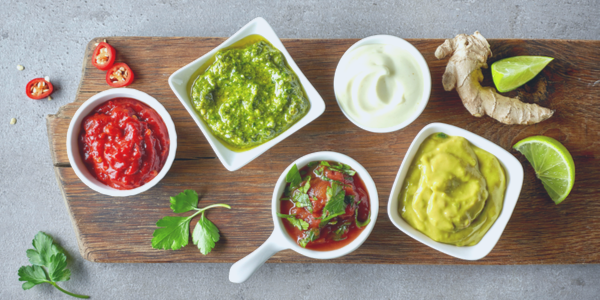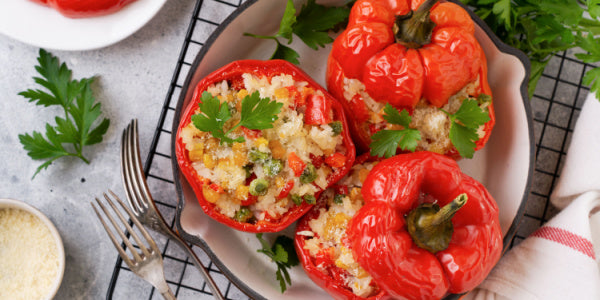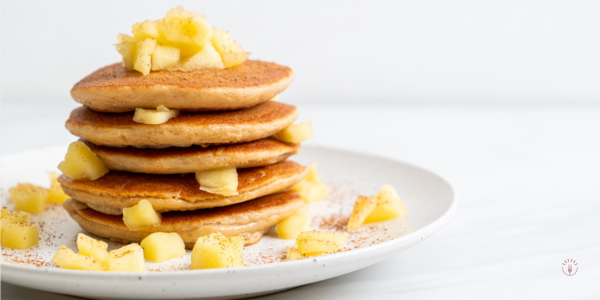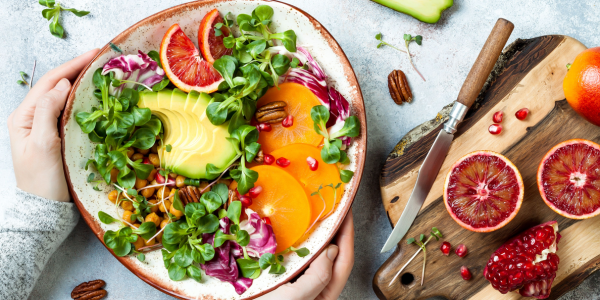
If you look at labels and nutrition facts for many popular condiments, you will notice they are high in added sugar, sodium, and preservatives. Some of the popular condiments higher in these ingredients include barbecue sauce, steak sauce, soy sauce, teriyaki sauce, ranch dressing, or mayo.
Does this mean all condiments should completely be avoided when trying to eat healthy? Of course not, and the good news is there are condiments that can fit into a healthy diet!
Discover the healthiest list of condiments and how to use them to add flavor to food without excess sugar, salt, or other questionable ingredients.
Top 10 Healthy Condiments to Liven Any Food
Having these pantry staple items on hand can mean you can use them alone or in combination to add flavor to almost any dish you make. Say goodbye to condiment bottles with long, questionable ingredient lists that are high in sugar and/or preservatives.
1. Extra Virgin Olive Oil
Extra virgin olive oil (EVOO) is a staple in Mediterranean cuisine and a component of what makes the Mediterranean diet so healthy. It is a good source of heart-healthy fats and antioxidants that help provide anti-inflammatory benefits to the body.
Extra virgin means the oil is harvested after the first press from the olives, which is thought to provide the most nutritional benefit. EVOO is best for dishes that require low to no cooking. It can be a staple for making your own dressing (see below) or drizzled on cooked dishes like pasta.
2. Vinegar
Vinegar is virtually a calorie and sugar-free condiment that adds an acidic component to salads, sandwiches, and stir fry dishes. There are many types of vinegar from apple cider, balsamic, red wine, or rice which can be used to add slightly different flavored vinegars.
For example, balsamic vinegar is commonly used in Italian dishes or with salads. Red wine or apple cider vinegar can be used for making vinaigrettes, marinades, or for making pickled vegetables. Rice vinegar is used in a variety of Asian dishes.
3. Mustard
According to Serious Eats, mustard is one of the world's oldest condiments, dating back to early Roman cooks. Whether the bright yellow mustard or paler (but more potent) dijon mustard, all types of mustard provide a flavor burst for sandwiches, burgers, hot dogs, chicken, or salad dishes.
While there are different types and textures of mustard available, honey mustard can have more added sugars compared to other mustard varieties.
4. Lemon/Lime Juice
A squeeze of lemon or lime juice can add a simple burst of flavor plus a good source of vitamin C. Citrus juices can be used as a condiment for many dishes, but most famously for seafood dishes and salads.
Bonus: Adding a squirt of the juices to dishes can also help increase iron absorption!
5. Plain Greek Yogurt
Sour cream and mayo are higher in fat and calorie condiments. Replacing them with plain Greek yogurt can be a lower fat and higher protein option. You still get the creamy flavor and texture but with more nutritional and health benefits.
Plain Greek yogurt can be added to tacos, burritos, baked potatoes, chili, and egg dishes.
6. Hot Sauce
Hot sauces range in heat level and intensity, but in general, are very low in calories. Some hot sauces, like sriracha and chili sauce, can have added sugar, so check labels on sauces first and watch portion sizes.
Depending on who you ask, hot sauce can be added to almost any savory dish. Some health experts suggest hot sauce may be the healthiest condiment to choose, as its main component, capsaicin, has anti-inflammatory and anti-cancer properties.
7. Nutritional Yeast
Nutritional yeast, also referred to as nooch or nature's Cheeto dust, is a savory, flavorful, flakey food addition. This popular food product, often used in vegan cooking, is full of nutrients and has a cheese-like taste.
Nutritional yeast pairs well with pasta, popcorn, salads, or roasted vegetables, just to name a few.
8. Nut or Seed Butters
Nut and seed butters are common additions to oatmeal, smoothies, or yogurt but the ways to use nut and seed butters go far beyond traditional ways. Slather on toast, muffins, pancakes, or waffles in place of higher sugar condiments like maple syrup. They can also be added to stews, chili, Asian dishes, or used for salad dressings.
Tahini, made from sesame seeds, can especially be paired with savory ingredients to create delicious sauces, spreads, and dressings.
9. Fermented or Pickled Veggies
Pickles, sauerkraut, and kimchi can elevate flavor profiles for sandwiches, grain bowls, and thrown on burgers or whatever else is put on the grill. The fermented veggies in sauerkraut and kimchi give an extra boost of probiotics that could help benefit gut health.
Kimchi is traditionally a Korean side dish made from fermented vegetables like cabbage and radishes and is served with many dishes, from breakfast to dinner. It can be found in the refrigerated section of most grocery stores, or you can also make your own kimchi!
Sauerkraut, kimchi, or pickles can be added to sandwiches, burgers, tacos, toast, wraps, or grain bowls for a tangy, crunchy addition.
10. Salsa
Like hot sauce, salsas come in a wide array of colors, textures, and heat levels. Use to customize individual preferences for a burst of flavor for traditional foods like tacos, burritos, chips, and egg dishes. Use as a replacement for other condiments for steak, chicken, pork, or vegetarian bean-based dishes as well.
Some salsas are higher in sodium than others. Check labels and choose ones with minimal ingredients besides tomatoes, peppers, and other vegetables. Or, make your own homemade salsa for a fresh and healthy condiment tailored to your preferences.
Healthy Condiment Combinations
Why stop at just one healthy condiment? Many can be paired up to make delicious and healthy condiments, sauces, and spreads. Here are some ways healthy condiments can join and balance flavors for an even richer flavor addition.
Make Your Own Salad Dressing
Olive oil plus any type of vinegar can be one of the easiest and healthiest salad dressings. However, making your own dressing can be done by pairing a combination of vinegar, oil, lemon juice, minced garlic, minced ginger, nut/seed butter, etc.
An easy example of a homemade dressing can be the following ingredients shaken together in a jar:
• 3 Tbsp dijon mustard
• 3 Tbsp champagne or red wine vinegar
• 1/2 tsp kosher salt
• Ground pepper to taste
• 1/2 cup olive oil
A homemade ranch or green goddess dressing can easily be made with plain Greek yogurt and a blend of spices as a healthier alternative to these creamy dressings.
Healthy Homemade Dips
Whether to pair with cut-up veggies, chips, or spread on a sandwich, a healthy dip can be a versatile condiment. Healthy dips can be made from a number of healthy condiments listed above. For example, you can pair together peanut butter with plain yogurt, a dash of cinnamon, and honey for a healthy dip for cut up fruit or spread on toast.
Nutritional yeast can be added to cashew cream sauce to make a versatile spread and dip for nachos. Also, mix into mac and cheese and whatever else you enjoy cheese sauce with.
Hummus can be made from a drained, rinsed can of chickpeas, some olive oil, tahini, lemon juice, garlic, and an optional amount of salt as a base. It can be another alternative for mayo on a sandwich or a tasty dip for vegetables, crackers, or chips.
Healthy Condiments Recap
Bottled condiments can be a surprising source of added sugar and sodium, which make them a target for cutting out when trying to eat healthy. However, this does not mean all condiments must be forsaken in the name of health.
Many condiments are naturally low in calories, sugar, and sodium and can add a delicious pop of flavor - either by themselves or paired with another healthy condiment. For example, extra virgin olive oil paired with vinegar can provide the backbone of a tasty, homemade, low sodium salad dressing.







